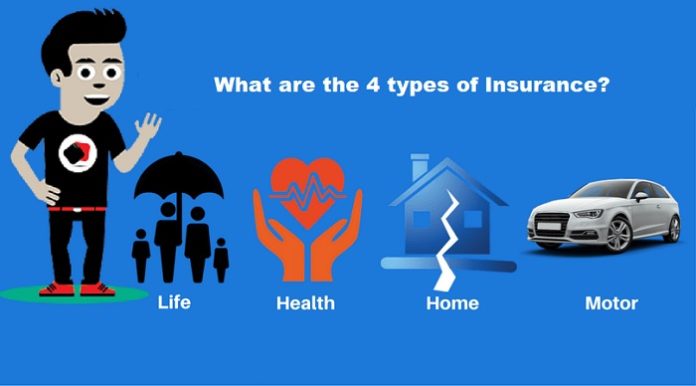In exchange for paying a premium, the insurance company agrees to bear the financial responsibility for certain risks or damages as specified in the insurance policy.
The basic principle of insurance is based on the concept of spreading risk among a large number of policyholders. The insurance company collects premiums from policyholders, pools the funds, and uses them to compensate those who experience covered losses or damages.
4 types of insurance
Life Insurance
Life insurance is a type of insurance that provides financial protection to the policyholder’s beneficiaries in the event of the policyholder’s death. It is designed to help alleviate the financial impact that may arise from the loss of a loved one who is financially responsible for others.
When a person purchases a life insurance policy, they pay regular premiums to the insurance company.
The death benefit is typically paid out as a lump sum, although some policies may offer the option of periodic payments.
There are many types of life insurance policies available
- Whole Life Insurance: It combines a death benefit with a savings component known as the cash value. The premiums for whole life insurance are typically higher than those for term life insurance, but a portion of the premium goes towards building the cash value, which can be accessed during the policyholder’s lifetime.
- Universal Life Insurance: Universal life insurance is a flexible type of policy that allows policyholders to adjust their premiums and death benefit amounts. Universal life insurance offers more flexibility in terms of premium payments and death benefit options compared to whole life insurance.
Life insurance serves a variety of purposes, such as providing financial support for dependents, paying off outstanding debt (such as a mortgage or loan), funding educational expenses for children, or leaving a charitable legacy.
Health Insurance
It is designed to help individuals and families manage the costs associated with medical care and protect against high healthcare expenses.
Here are some key aspects of health insurance
- Coverage Options: Health insurance plans can vary in terms of coverage options and flexibility. Common types of health insurance include employer-sponsored plans, government programs like Medicare and Medicaid, and individual or family plans purchased directly from insurance companies.
- Network Providers: Health insurance plans often have a network of healthcare providers, including doctors, hospitals, and specialists, with whom they have negotiated contracts and discounted rates. These are called in-network providers. It is important to check if your preferred healthcare providers are part of the insurance network to ensure coverage and minimize out-of-pocket costs. Some plans may also offer coverage for out-of-network providers, but at a higher cost to the policyholder.
- Deductibles, Copayments, and Coinsurance: Health insurance plans typically have cost-sharing mechanisms that require the policyholder to contribute towards their medical expenses. This may include deductibles, which is the amount the policyholder must pay out of pocket before the insurance coverage kicks in. Additionally, copayments and coinsurance are the portion of the costs the policyholder pays at the time of receiving medical services.
- Benefits and Coverage Limits: Health insurance policies outline the specific benefits and coverage limits for different types of medical services. These can include limits on the number of visits, certain procedures, prescription drug coverage, and more. It’s important to review the policy details to understand what is covered and any limitations or exclusions that may apply.
Health insurance helps individuals and families get the medical care they need by reducing the financial burden associated with healthcare costs. It promotes regular preventive care, timely treatment.
Auto Insurance
Auto insurance is a type of insurance that provides coverage for damages and liability in case of accidents involving automobiles.
Also read: Complete Guide to 8 Types of Insurance Organizations
It is designed to protect both the vehicle owner and other parties involved in an accident from financial losses and legal liabilities.
Some key aspects of auto insurance
- Liability Coverage: Liability coverage is a fundamental component of auto insurance and is required in most jurisdictions. It covers the policyholder’s legal liability for bodily injury and property damage caused to others in an accident for which the policyholder is at fault. It helps to compensate the injured parties for medical expenses, vehicle repairs, and other related costs.
- Property Damage Coverage: Property damage coverage pays for the repair or replacement of other people’s property, such as vehicles, buildings, or structures, that are damaged in an accident caused by the insured. This coverage is typically included as part of the liability coverage.
- Comprehensive Coverage: Comprehensive coverage protects against damage to the insured vehicle caused by non-collision events, such as theft, vandalism, fire, natural disasters, or falling objects. It also covers expenses related to repairing or replacing a stolen vehicle.
Auto insurance policies may have different coverage limits and deductibles, which are the amounts the policyholder is responsible for paying out of pocket before insurance coverage applies.
Property Insurance
Property insurance is a type of insurance that provides coverage for financial losses or damages to physical assets, such as homes, buildings, and their contents. It is designed to protect property owners from unexpected events that may cause damage or loss.
Some key aspects of property insurance
- Homeowners Insurance: Homeowners insurance is a common type of property insurance that covers residential properties. It typically provides coverage for the structure of the home, personal belongings, and liability protection in case someone is injured on the property. Homeowners insurance may also include additional coverage for events like fire, theft, vandalism, and natural disasters, depending on the policy and its specific terms.
- Renters Insurance: Renters insurance is similar to homeowners insurance but is designed for individuals who rent their living space instead of owning it. It provides coverage for the renter’s personal belongings and liability protection. Renters insurance may also offer additional coverage options, such as temporary living expenses if the rented property becomes uninhabitable.
- Commercial Property Insurance: Commercial property insurance is specifically tailored for businesses and provides coverage for buildings, inventory, equipment, and other assets owned by the business. It protects against losses due to events like fire, theft, vandalism, and natural disasters. Business interruption coverage may also be included to compensate for lost income and ongoing expenses in the event of a covered loss that disrupts business operations.
Property insurance helps property owners and tenants protect their investment and assets by providing financial compensation in the event of a covered loss or damage.







